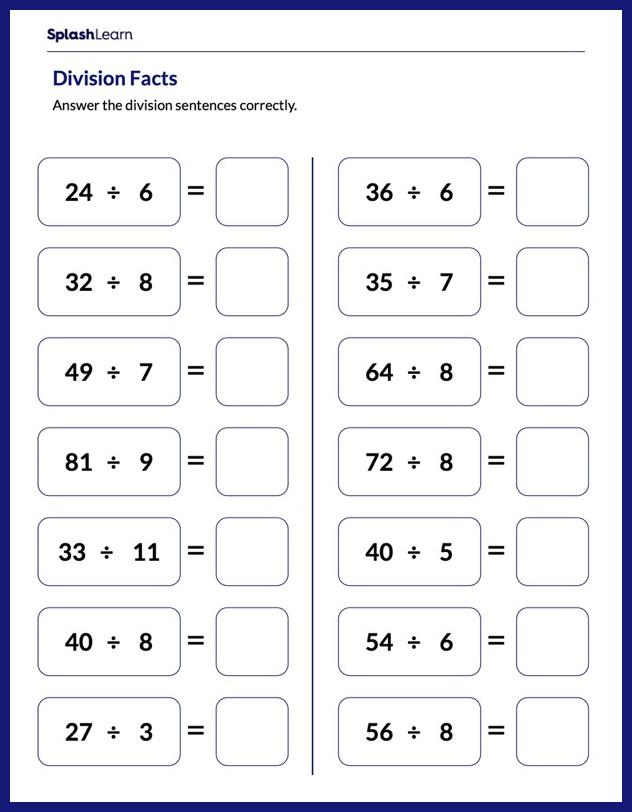What Is a Partial Quotient?
A partial quotient refers to a division strategy that uses repeated subtraction to perform the division of large numbers easily.
The partial quotient method is used in long division to break down a division problem into simpler, more manageable steps. It involves finding partial quotients for each part of the dividend. These partial quotients are then added together to obtain the final quotient.
This approach is useful when dealing with large division problems since it makes division more understandable and less overwhelming for kids. The partial quotient method is also called the “chunking method” since it breaks down a large number into smaller parts.
Recommended Games
What Is a Quotient?
The quotient is the number we obtain when dividing one number (dividend) by another (divisor). Note that the quotient is always smaller than the dividend.
Example: $8 \div 4 = 2$
Here, 8 is the dividend, and 4 is the divisor.
The result of the division is 2.
Thus, 2 is the quotient.
NOTE: In this example, we are dealing with small numbers. So, it is very easy to check the times tables, recall the multiplication facts, and work out the quotient. It would be challenging to identify the quotient when the numbers are large. That’s where the partial quotients come into the picture.
Recommended Worksheets
Partial Quotient Definition
Partial quotient is a division method that breaks down a dividend into smaller parts, enabling easier subtraction of multiples of the divisor until the remainder is smaller than the divisor.
Understanding Partial Quotients as a Division Strategy
The division operation is defined as the process of repeated subtraction. It is exactly the opposite of multiplication. In the standard form of division, the divisor is used to determine how many times it can be subtracted from the dividend.
Example: $20 \div 5$
$20 – 5 = 15$
$15 – 5 = 10$
$10 – 5 = 5$
$5 – 5 = 0$
5 is subtracted 4 times to get the remainder of 0.
$20 \div 5 = 4$
Here, we can easily identify that
$5 \times 4 =$ Four groups of $5 = 5 + 5 + 5 + 5 = 20$
Thus, quotient $= 4$
In the partial quotient division, we break the dividend into smaller parts by subtracting multiples of the divisor until the remainder is 0 or less than the divisor. The multipliers (numbers used to multiply the divisor to find these multiples) are the partial quotients, which are then summed to find the final quotient.
Example: $285 \div 5$
Using repeated subtraction, we will have to subtract 5 multiple times to find the quotient. It would be tedious. Instead, we can use the partial quotients.
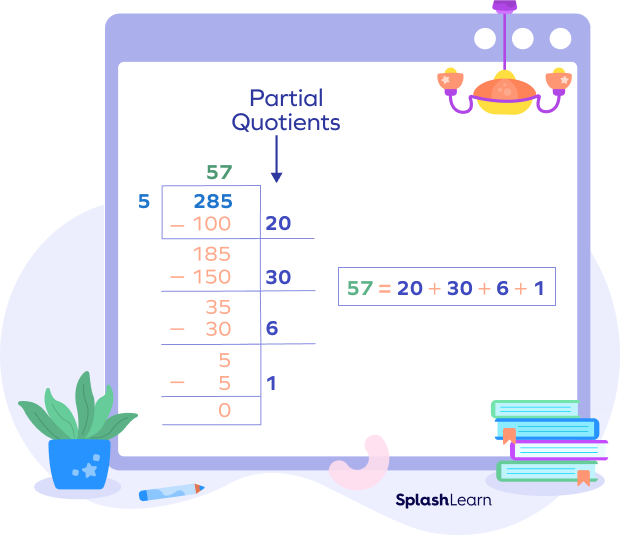
Thus, 5 can be subtracted 57 times from 285. To reach the final quotient of 57, we preferred chunking the division process into smaller steps. The outcome is the same, no matter how many steps you choose. The numbers with which the divisor is multiplied during this process are called the partial quotients.
NOTE: The partial quotients method is not limited to a single correct sequence of steps. It’s more about breaking down the division into manageable steps by finding multiples of the divisor and subtracting them from the dividend until the problem is solved.
You can choose different multiples of the divisor to subtract from the dividend in each step, making the method adaptable to the specific problem you are trying to solve. The idea is to find multiples that make the computation easier and more understandable.
The goal is to help students understand the concept of division and place value while allowing for flexibility in their approach.
Here’s how we can solve the same example using different partial quotients.
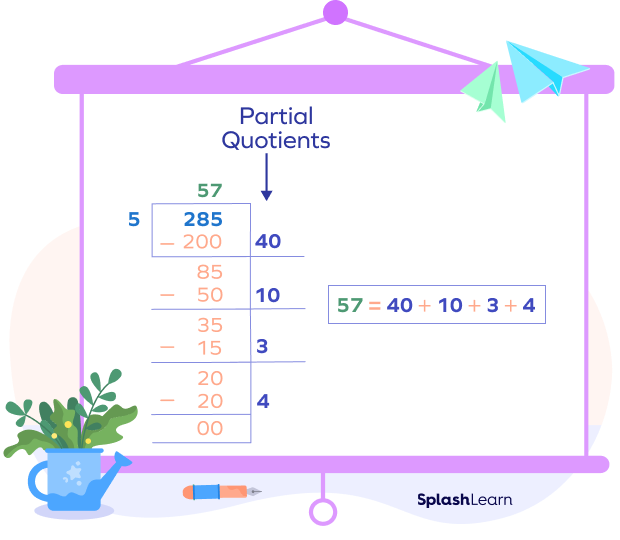
How to Divide Using the Partial Quotient Method
Let’s understand the steps to divide using the partial quotients with the help of an example.
- Identify the dividend and the divisor: Understand the division problem, which consists of a dividend (the number to be divided) and a divisor (the number you’re dividing by).
- Estimate Partial Quotients: Choose a multiple of the divisor that is as close as possible to the dividend without exceeding it. The best approach would be to write simple multiplication facts of the divisor (such as multiples of 10).
The multiplier of the divisor at every step of this division is the partial quotient. This multiple of the divisor should be as close as possible to the dividend, that is, less than or equal to the dividend.
- Subtract: Subtract the multiple from the dividend to find the remainder.
- Continue the process: If the remainder is not zero, repeat the process. Find another multiple of the divisor that can be subtracted from the remaining dividend to obtain the next partial quotient. Repeat this process until the remainder is 0 or less than the divisor.
- Combine Partial Quotients: Keep finding partial quotients and subtracting them until the remainder is zero or less than the divisor. Then, add all the partial quotients together to obtain the final quotient.
- Check your answer: Verify that your answer is correct by multiplying the divisor by the quotient and adding any remaining remainder. It should equal the original dividend.
Example 1: Divide 378 by 6 using partial quotients.
Dividend $= 378$
Divisor $= 6$
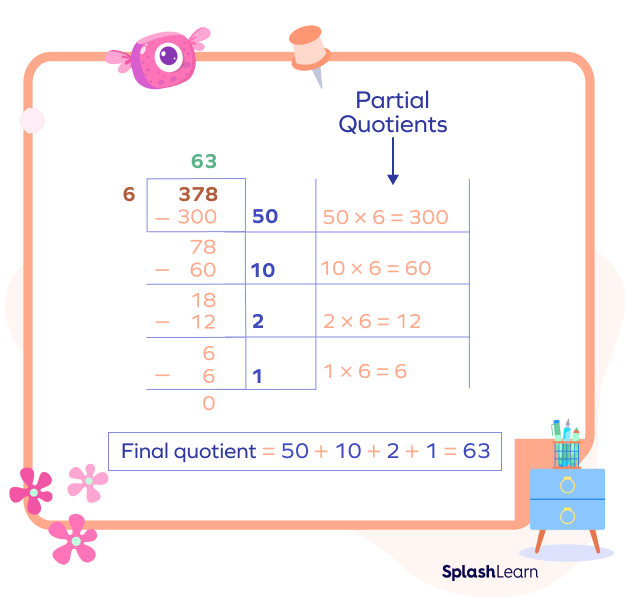
Example 2: Let’s consider an example where the remainder is not 0.
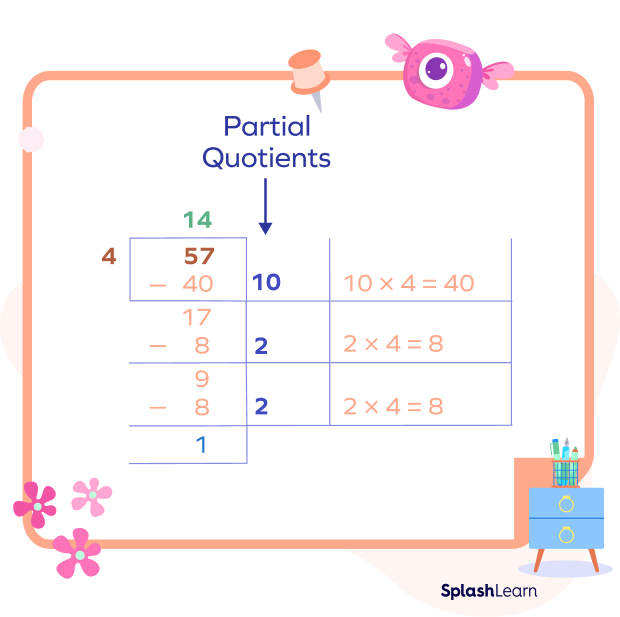
Adding the partial quotients, we get
$10 + 2 + 2 = 14$
We also have a remainder of 1.
Thus, $57 \div 4 = 14$ R 1
We can also write this using mixed fractions as
$57 \div 4 = 14 \frac{1}{4}$
How to Use Partial Quotients to Divide by One-Digit Numbers
The steps are the same. Let’s consider an example. Let’s divide 78 by 3.
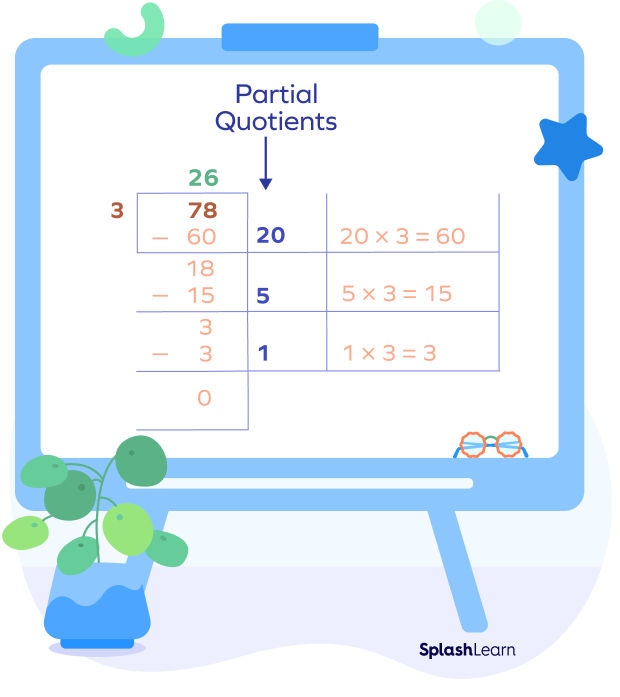
How to Use Partial Quotients to Divide by Two-Digit Numbers
The process discussed earlier stays the same regardless of the number of digits in the divisor.
Example: $1275 \div 15$
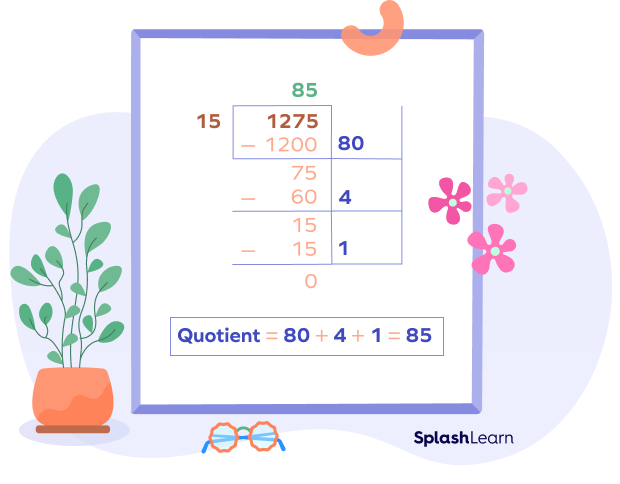
Partial Quotients Using Area Model
The area model division method visually represents division using rectangles, where the partial quotients and the divisor determine the length and width of these rectangles. Each partial quotient corresponds to the length of one rectangle. The combined area of these rectangles equals the dividend of the division equation.
Example: $275 \div 25$
Dividend $= 275$
Divisor $= 25$
We can choose as many rectangles as we choose the number of partial quotients.
Suppose we choose two partial quotients, 10 and 1.
Division Step i)
$25 \times 10 = 250$
$275 – 250 = 25$
Division Step ii)
$25 \times 1 = 25$
$25 – 25 = 0$
Consider two rectangles, both having a width equal to the value of the divisor, 25.
Divisor $= 25 =$ Width of the rectangles
Length of one rectangle $= 25$ …partial quotient
Length of the other rectangle $= 1$ …partial quotient
Sum of partial quotients $= 10 + 1 = 11 =$ Length of the big rectangle
Sum of areas of two rectangles $= 250 + 25 = 275$ square units = Dividend
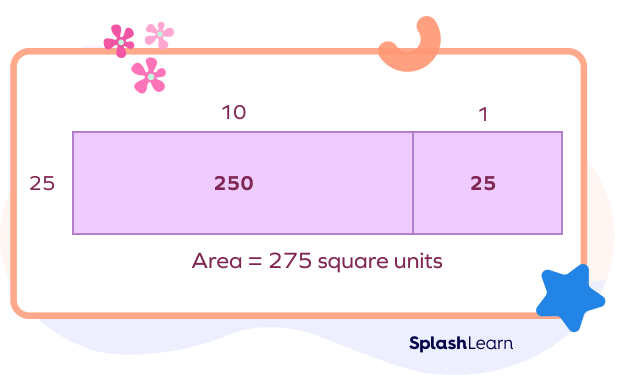
How to Divide Decimals Using Partial Quotients
Let’s understand how to divide decimals using partial quotients. The process is similar, but we must consider the decimal point at every step.
Example: $9.7 \div 4 = 2.425$
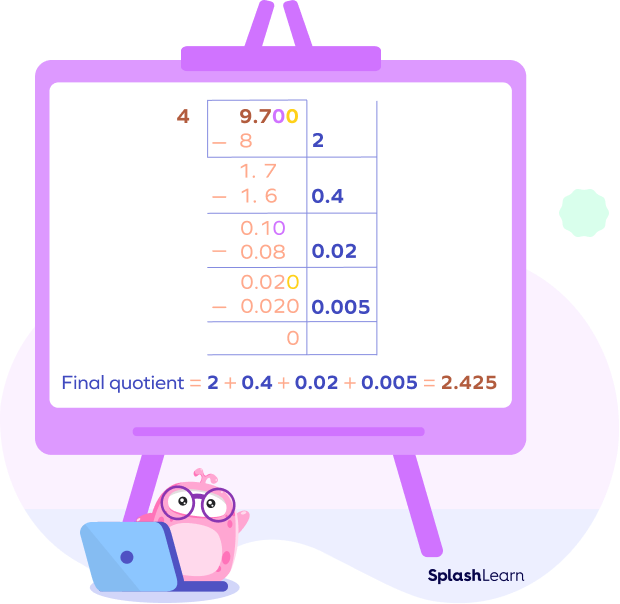
Facts about Partial Quotients
- The partial quotient division approach makes long division easier. It offers flexibility, allowing students to adjust the amount they subtract at each step based on their preferred calculation method.
- The partial quotient strategy may be more time-consuming than traditional division methods due to its potential for more steps, particularly when dealing with larger numbers.
Conclusion
In this article, we learned about the partial quotient division method. We discussed how to divide numbers and decimals easily using partial quotients. Let’s solve a few examples for better comprehension.
Solved Examples on Partial Quotients
1. Solve 112 ÷ 4 using partial quotients.
Solution:
Let’s use the partial quotients method.
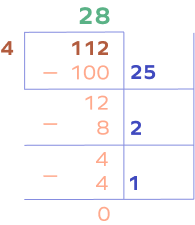
Quotient $= 25 + 2 + 1 = 28$
Thus, $112 \div 4 = 28$
2. Solve 108 ÷ 3 using partial quotients.
Solution:
Let’s use the partial quotient method.
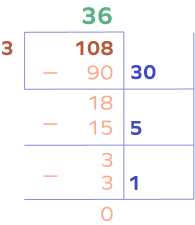
Final quotient $= 30 + 5 + 1 = 36$
Thus, $108 \div 3 = 36$
3. Find partial quotients and the final quotient.
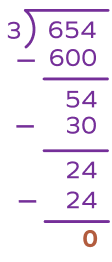
Solution:
Dividend $= 654$
Divisor $= 3$
1st partial quotient $= 200$ since $200 \times 3 = 600$
2nd partial quotient $= 10$ since $10 \times 3 = 30$
3rd partial quotient $= 8$ since $8 \times 3 = 24$
Final quotient = Sum of partial quotients $= 200 + 10 + 8 = 218$
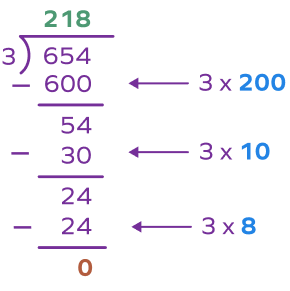
Practice Problems on Partial Quotients
Partial Quotient
What is the first step when dividing a number using the partial quotient method?
In the first step, we multiply the divisor by a number to reach a friendly number closer to the dividend.
What are partial quotients?
The multipliers of the divisor (the numbers you multiply the divisor by) we use in the division process are called partial products.
In the partial quotients method, what do you do after finding the partial quotient for each step?
In the final step, we add them all to get the quotient.
Frequently Asked Questions about Partial Quotients
What is the significance of partial quotients?
Partial quotients provide the simple transition from a visual approach to division to a more abstract one, addressing a gap in understanding. It helps students to simplify the long division process into smaller and easy-to-understand steps.
Are partial quotients unique?
Partial quotients in division are not unique; they can vary depending on the way you choose to approach a particular division problem. The flexibility of the partial quotients method is one of its advantages, as it allows for different approaches that suit the problem and the student’s understanding.
Which value should necessarily be less than the divisor?
The remainder should necessarily be less than the divisor.
How do you define division?
Division is the process of repeated subtraction, where we determine how many times the divisor can be subtracted from the dividend until the remainder is 0 or less than the divisor.
What is the division formula?
Dividend = (Divisor × Quotient) + Remainder


































